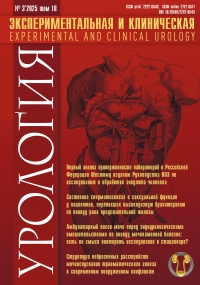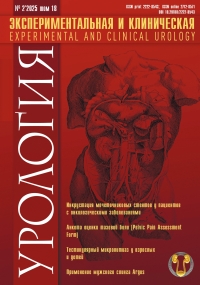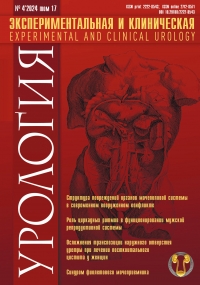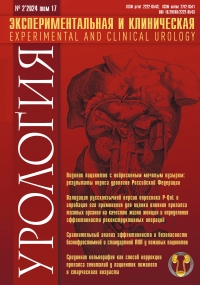Peer review
 9725
9725 The editorial board members of the “Experimental and clinical urology” journal is very grateful to all the experts, taking part in the workflow on each journal issue
Peer review process for articles submitted to the “Experimental and clinical urology” journal.
Double-blind review.
The scheme of the process is located below.

Stages:
- Peer review is required for all scientific articles submitted to the editorial office.
- The executive secretary determines whether the received manuscript comply with the profile of the journal and the requirements for its design.
- A member of the editorial board, who oversees one of the scientific areas, sends it for review to a specialist, doctor or PhD, working in another medical institution, whose scientific specialization is close to the topic of the article.
- Responsibility for the quality of reviews and the timeliness of manuscript peer reviewing lies with a member of the editorial board in charge of this research area.
- The terms for peer reviewing in each individual case are determined by the deputy chief editor or a member of the editorial board in charge of one of the scientific areas.
- The reviews are confirmed by the personal signature of the reviewer indicating the date of the review.
- Peer reviewing is carried out confidentially. Reviewers have to be aware that the manuscripts sent to them are the intellectual property of the authors and relate to information, that is not to disclosure. Violation of confidentiality is possible only if the reviewer claims that the materials contained in the manuscript are unreliable or falsified.
- If the review contains recommendations for correcting and finalizing the article, the deputy chief editor sends the author the text of the review with a proposal to take the recommendations into account when preparing a new version of the article or to refute them in part or in full. The finalized (revised) by the author article is resent for peer review to the same reviewer who made critical comments.
- An article, that was not recommended by the reviewer for publication is submitted for review to another specialist reviewer, and in the event of a repeated negative review, it is not accepted for publication.
- A positive peer review result is not a sufficient condition for article publication. The final decision on the advisability of publication and the timing of publication is made by the Chief Editor or his deputy.
- Not allowed for publication:
- articles, the authors of which refuse technical revision of the articles, that are not designed in accordance with the requirements
- articles whose authors do not comply with the constructive comments of the reviewer or do not refute them reasonably;
- articles that have not passed the peer-review procedure.
- It is required for the review indicate the conformity of the article to its title, characterize its relevance and scientific level, advantages and disadvantages, and evaluate the appropriateness of publication.
- The review is provided to the author of the article, as well as to the Ministry of Education and Science after a request, without a signature, name, and position of the reviewer.
- If the reviewer recommends correcting or elaborating the article, the head of the editorial office sends the author the text of the review to make appropriate changes to the article.
- A motivated refusal is sent to an author whose article was not accepted for publication. If necessary, at the insistence of the author, an additional review of the manuscript by another specialist can be carried out.
- The final decision on the article publication and its timing is made by the editorial board by a majority of votes by open direct vote. In some cases, if there is a positive review, it is possible to publish an article by a joint decision of the editorial board chairman and the chief editor.
- The originals of reviews are kept in the editorial office and by publisher for 5 years.
- In his work, the reviewer is guided by The Singapore Statement on Research Integrity (2010).
- Reviewers work with the article as confidential material, strictly observing the author’s right to non-disclosure before publishing the information contained in the article. Reviewing has the character of a “one-sided blind”, in which the reviewer knows the author’s name, and the author does not have information about the reviewer, which provides for the presence of two or more reviewers.
- The editors send copies of reviews to the Ministry of Education and Science of the Russian Federation upon request.
Reviewer Responsibilities
- In order to contribute to the decision-making process regarding the advisability of publishing an article and to assist in improving the quality of the article, the reviewer has to act objectively and in a timely manner.
- Confidentiality must be maintained with respect to any information provided by the editor or author. The reviewer should not keep a copy of the article.
- It is necessary to warn the editor of materials published earlier in this or another journal.
- The reviewer is obliged to warn the editor and, if necessary, transfer the article to another reviewer in case of a potential conflict of interest (financial, organizational or other relations between the reviewer and the author).

















































































